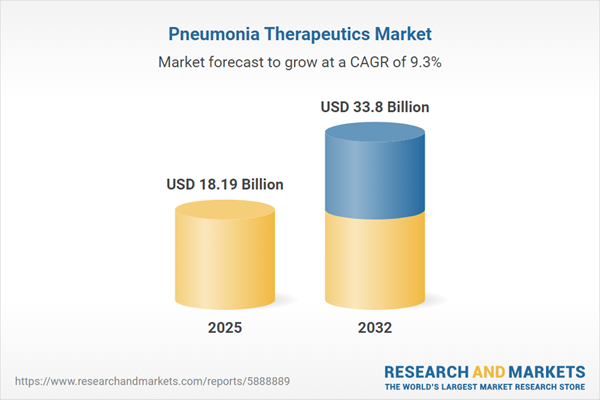Speak directly to the analyst to clarify any post sales queries you may have.
Senior decision-makers in healthcare must navigate a fast-changing pneumonia therapeutics market shaped by expanding treatment modalities and evolving patient needs. Gaining actionable market intelligence is increasingly essential for making informed strategic investments, improving care quality, and building a stronger competitive position in the global landscape.
Pneumonia Therapeutics Market Snapshot
The pneumonia therapeutics market is registering substantial growth, expanding from USD 16.64 billion in 2024 to USD 18.19 billion in 2025, with a projected value of USD 33.80 billion by 2032, reflecting a CAGR of 9.26%. This notable trajectory underscores the rapid adoption of innovative therapies and a greater integration of advanced diagnostics into clinical workflows. Pharmaceutical organizations are adapting to regulatory changes and evolving healthcare economics, impacting innovation and shaping patient access strategies. These shifts are generating diverse opportunities for differentiation, portfolio expansion, and long-term growth as the therapeutic environment continues to evolve.
Pneumonia Therapeutics Market Scope & Segmentation
This comprehensive report provides in-depth segmentation and detailed market intelligence to support executive decision-making, resource allocation, and strategic benchmarking across geographic regions and therapy types. The segmentation model is designed to drive more effective competitiveness initiatives and deliver improved patient outcomes.
- Therapy Type: Evaluation includes adjunctive therapies such as corticosteroids and nebulizers, plus a range of anti-infective agents like antibiotics, antifungals, antivirals, and biologics—spanning immune modulators and monoclonal antibodies. The scope covers all supportive interventions required for pneumonia management, from fluid management to oxygen therapy and mechanical ventilation.
- Route of Administration: Assessment of inhalation, intravenous, and oral formats ensures product strategies fit real-world clinical and operational contexts, facilitating precise, patient-tailored therapies.
- Distribution Channels: Analysis covers hospital, online, and retail pharmacy channels, clarifying the impact of access, delivery logistics, and supply chain efficiency on therapy deployment.
- Patient Age Groups: Segmentation explores adult, geriatric, and pediatric populations, revealing demand variations, unique risk profiles, and corresponding therapeutic responses.
- Pathogen Types: The report addresses coverage for atypical pathogens, such as Chlamydophila, Legionella, and Mycoplasma, alongside pathways focused on bacterial, viral, and fungal infections.
- Indication Types: Community-acquired, hospital-acquired, and ventilator-associated cases are analyzed to improve targeting and optimize interventions.
- Regions: Detailed examination of Americas, Europe, Asia-Pacific, Middle East, and Africa, with attention to differing clinical standards, reimbursement environments, and regulatory structures affecting regional strategies.
- Key Companies Profiled: The landscape features Pfizer Inc., GlaxoSmithKline plc, Merck & Co., Inc., Sanofi S.A., Johnson & Johnson, Novartis AG, AstraZeneca plc, Bayer AG, Teva Pharmaceutical Industries Ltd., and Dr. Reddy’s Laboratories Ltd. This enables comprehensive benchmarking and supports informed partnership considerations.
Pneumonia Therapeutics: Key Takeaways for Senior Leaders
- Expanded molecular diagnostics and digital technologies are expediting clinical decisions, fostering better care quality and responsiveness in pneumonia therapy.
- Growth in personalized medicine, including advanced immunomodulators and diagnostics, enables organizations to tailor treatments for distinct patient segments and enhance service differentiation.
- Collaboration across pharmaceutical firms, diagnostic companies, and contract manufacturers is central to accelerating therapeutic innovation and expanding international reach.
- Flexible approaches to healthcare policy and regulatory requirements across regions—especially in Asia-Pacific and the Americas—help organizations strengthen resilience and support calculated market expansion.
- Supply chain adaptation and operational agility are vital to manage regulatory changes, meet shifting demand, and support continuity of care in pneumonia therapeutics.
Tariff Impact: Navigating Regulatory and Economic Change
With the implementation of 2025 US pharmaceutical tariffs, companies face increased costs for imported active ingredients and finished therapies. This shift has prompted a transition to regional sourcing, ramp-up of domestic production, and the formation of new contract manufacturing partnerships to reinforce long-term supply resilience. While these adjustments require investment in resources and process optimization, they also position firms for greater adaptability. Concurrently, the emergence of value-based reimbursement is driving tighter alignment between commercial and compliance functions, directly influencing pricing strategies, patient access, and competitive market planning.
Methodology & Data Sources
The research synthesizes insights from expert interviews, regulatory documents, peer-reviewed literature, clinical trials, and proprietary market data. Analytics sourced from public health agencies and pharmaceutical sales records enhance the validity and reliability of the recommendations provided.
Why This Report Matters
- Empowers C-suite executives with focused intelligence for prioritizing market growth and regulatory compliance within the pneumonia therapeutics landscape.
- Clarifies emerging innovation and competitor movements to guide R&D prioritization, informed product launches, and entry strategies across global markets.
- Offers actionable recommendations on supply chain restructuring and operational planning to support efficiency and organizational growth objectives.
Conclusion
Armed with timely insights, senior executives can better anticipate shifts in the pneumonia therapeutics market, adapt to complex regulatory and patient demands, and build agile, competitive organizations poised for long-term success.
Additional Product Information:
- Purchase of this report includes 1 year online access with quarterly updates.
- This report can be updated on request. Please contact our Customer Experience team using the Ask a Question widget on our website.
Table of Contents
3. Executive Summary
4. Market Overview
7. Cumulative Impact of Artificial Intelligence 2025
List of Figures
Samples

LOADING...
Companies Mentioned
The key companies profiled in this Pneumonia Therapeutics market report include:- Pfizer Inc.
- GlaxoSmithKline plc
- Merck & Co., Inc.
- Sanofi S.A.
- Johnson & Johnson
- Novartis AG
- AstraZeneca plc
- Bayer AG
- Teva Pharmaceutical Industries Ltd.
- Dr. Reddy’s Laboratories Ltd.
Table Information
| Report Attribute | Details |
|---|---|
| No. of Pages | 185 |
| Published | October 2025 |
| Forecast Period | 2025 - 2032 |
| Estimated Market Value ( USD | $ 18.19 Billion |
| Forecasted Market Value ( USD | $ 33.8 Billion |
| Compound Annual Growth Rate | 9.2% |
| Regions Covered | Global |
| No. of Companies Mentioned | 11 |









